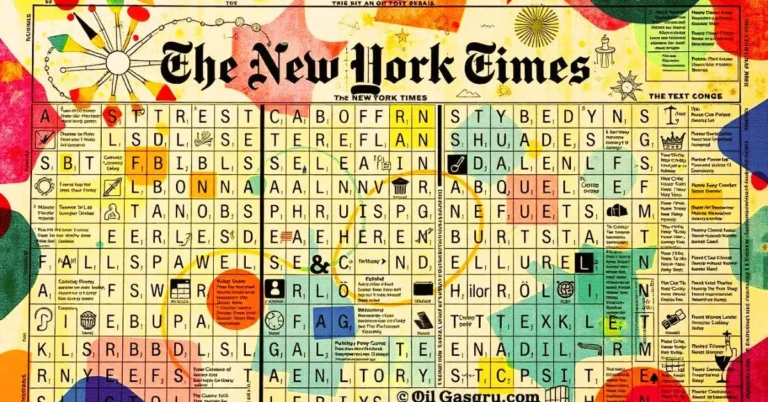The New York Times crossword puzzle has long been regarded as a staple for puzzle enthusiasts across the world. A particularly intriguing aspect of these puzzles is the clues themselves. One such clue that might appear on a particularly challenging day is the phrase “wide display.” For crossword solvers, interpreting such clues is essential to solving the puzzle efficiently. In this article, we will explore what it means to approach a clue like wide display NYT crossword the strategies involved in solving it, and how this clue fits within the broader puzzle-solving experience.
What Is a Wide Display in a NYT Crossword?
Wide display NYT crossword could refer to several different types of clues or solutions, depending on the context of the puzzle. It could be a clue that hints at the physical characteristic of something—a device, for instance, that has a wide display. Alternatively, it might refer to a metaphorical or symbolic “wide display,” suggesting something on a grand scale or of significant importance.
In terms of crossword puzzle solving, the importance of understanding the precise meaning behind the phrase cannot be understated. Crosswords are full of wordplay and puns, and “wide display” might not always mean a literal “screen” or “monitor,” but rather something like a “vista” or “view” that spans across a large area. Solvers need to be aware of these nuances and keep an open mind when interpreting clues.
The Role of Context in Solving “Wide Display” Clues
As with many crossword clues, context plays a crucial role in narrowing down the possible answers. When a clue reads “wide display,” the surrounding clues can offer vital hints. If other clues are pointing toward technological or digital terms, the answer may be related to something like “TV,” “monitor,” or “screen,” which are all devices known for their wide displays. However, if the context suggests something more artistic or landscape-related, the answer might be related to “vista” or “panorama.”
Solvers must analyze the other words in the puzzle and use them to inform their interpretation of a clue like “wide display.” This is a classic example of how solving an NYT crossword is an exercise in both patience and creativity, as solvers need to piece together different types of knowledge—from pop culture to geography, science, and language.
Clue Structure: How Wide Display Fits in the Puzzle

Crossword clues typically follow a particular structure, with both straightforward and cryptic elements mixed in. A clue like “wide display” would most likely be in a straightforward format. However, even straightforward clues can have subtle tricks to them, requiring solvers to think outside the box.
In the case of wide display NYT crossword if the answer is related to a device, it would likely fit with other technical or gadget-related clues, and the surrounding answers would help verify whether the solution fits the puzzle grid. If the answer is “screen” or “monitor,” the letters in those words would intersect with others that are similarly thematic.
One of the challenges of crossword puzzle solving is understanding how specific answers fit within the grid. The solver not only has to figure out what the correct answer to a clue like “wide display” is, but also ensure it fits logically with all the intersecting clues. This is especially important when solving more complex puzzles, where multi-letter answers play a significant role in the overall completion of the puzzle.
Common Solutions to “Wide Display” Clues
When approaching a clue such as wide display NYT crossword solvers may need to consider a variety of possible answers. Common solutions could include:
- Screen: As mentioned earlier, screens are synonymous with wide displays. This answer would be common in a puzzle related to technology or electronics.
- Monitor: Like “screen,” a monitor refers to a device used to display images or information, often with a wide screen.
- Vista: This term can also fit as a wide display, but in a more poetic or geographical sense, referring to a wide and expansive view.
- Panorama: Another possible solution, “panorama” is often used to describe a wide and sweeping view, particularly in photography or nature.
- Theater: In some contexts, “wide display” might refer to a theater screen, as many modern theaters feature wide-format displays for film presentations.
- Array: An “array” can be used metaphorically to describe a large, organized display, often in scientific or mathematical contexts.
Each of these solutions demonstrates how a seemingly simple clue like “wide display” can lead to a variety of potential answers. Solvers must use their understanding of both language and context to determine the most likely solution.
Strategies for Solving “Wide Display” Clues

Solving a clue like wide display NYT crossword requires a few strategies that all crossword enthusiasts should keep in mind:
- Consider Different Meanings: As seen above, “wide display” can refer to many different things—electronics, geography, art, or even metaphorical language. Consider all the possible meanings of “wide” and “display” before making a decision.
- Use the Crossword Grid: Take note of the letters already filled in and how they intersect with the “wide display” clue. This will help guide your thinking and narrow down the list of possible answers.
- Leverage Cross Clues: Cross clues are your best friend when solving tricky ones. If you have difficulty with “wide display,” check the clues crossing through it to see if they suggest a direction that fits with the pattern.
- Think About Thematic Connections: Sometimes, crossword puzzles have overarching themes, and recognizing a pattern within the theme can help solve difficult clues. If other clues are tech-related or related to geography, it could help you focus on relevant answers for “wide display.”
- Check for Synonyms: “Wide display” could be a direct reference to a synonym, so don’t hesitate to think of words with similar meanings.
The Importance of Precision in Crossword Solving
While it may seem trivial, getting clues like “wide display” correct is vital for completing a crossword puzzle. One mistake can throw off the entire grid, leading to frustration for the solver. Crossword solvers, therefore, must not only focus on finding the correct answer but also on ensuring it fits properly within the context of the puzzle.
In the case of a NYT crossword, precision is key. The puzzles are designed to be challenging, and they require solvers to think carefully about each clue. Whether the clue is simple or complex, such as “wide display,” every answer must make sense both on its own and within the grid.
Conclusion
The wide display NYT crossword clue is just one of many that crossword solvers may encounter in their puzzle-solving journey. While it may seem straightforward, it requires careful thought, context analysis, and sometimes even a little bit of creative thinking to solve. By considering different meanings, using cross clues, and thinking about thematic connections, solvers can efficiently navigate through the puzzle and arrive at the correct answer.
Ultimately, solving crossword puzzles like those found in the New York Times is more than just about answering a few questions. It’s about engaging with language, expanding one’s knowledge, and honing problem-solving skills. Whether you’re tackling “wide display” or any other clue, the key is to approach it with patience, perseverance, and a willingness to learn. With these strategies in mind, you’ll be well-equipped to tackle any crossword puzzle that comes your way.
Read more: The Big Plus NYT Crossword Clue A Comprehensive Guide



